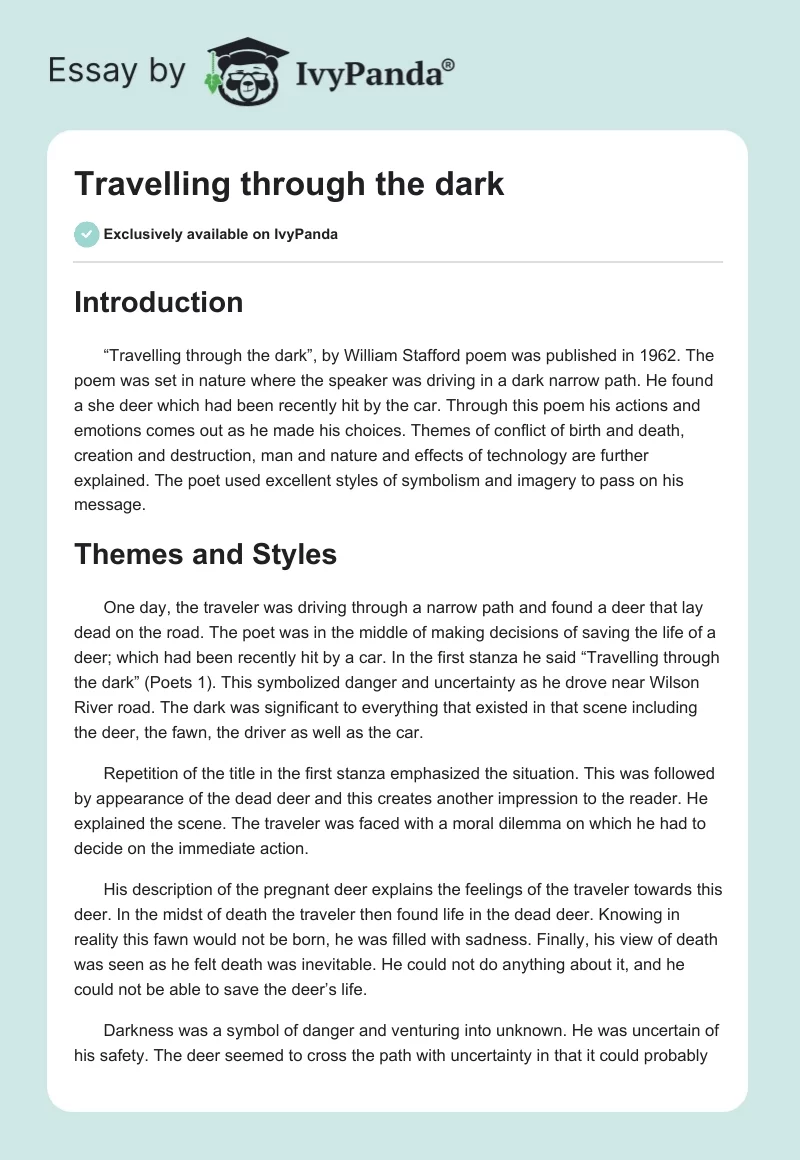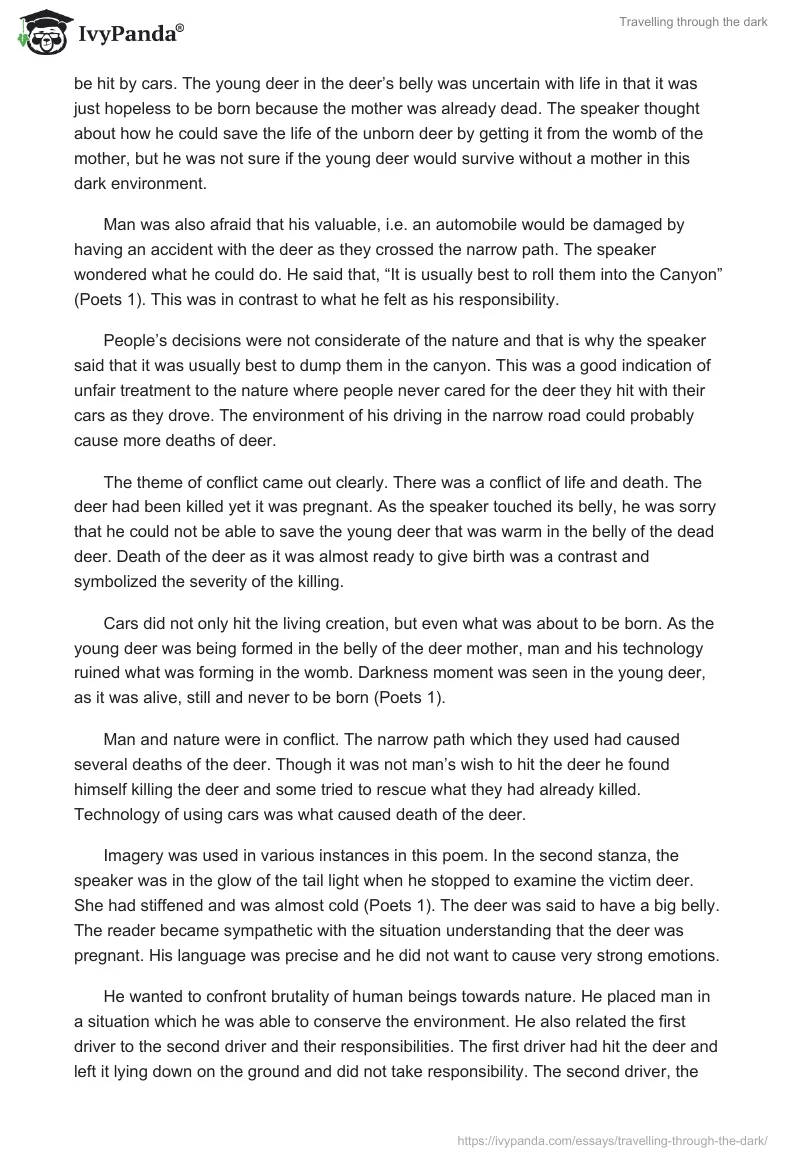Introduction
“Travelling through the dark”, by William Stafford poem was published in 1962. The poem was set in nature where the speaker was driving in a dark narrow path. He found a she deer which had been recently hit by the car. Through this poem his actions and emotions comes out as he made his choices. Themes of conflict of birth and death, creation and destruction, man and nature and effects of technology are further explained. The poet used excellent styles of symbolism and imagery to pass on his message.
Themes and Styles
One day, the traveler was driving through a narrow path and found a deer that lay dead on the road. The poet was in the middle of making decisions of saving the life of a deer; which had been recently hit by a car. In the first stanza he said “Travelling through the dark” (Poets 1). This symbolized danger and uncertainty as he drove near Wilson River road. The dark was significant to everything that existed in that scene including the deer, the fawn, the driver as well as the car.
Repetition of the title in the first stanza emphasized the situation. This was followed by appearance of the dead deer and this creates another impression to the reader. He explained the scene. The traveler was faced with a moral dilemma on which he had to decide on the immediate action.
His description of the pregnant deer explains the feelings of the traveler towards this deer. In the midst of death the traveler then found life in the dead deer. Knowing in reality this fawn would not be born, he was filled with sadness. Finally, his view of death was seen as he felt death was inevitable. He could not do anything about it, and he could not be able to save the deer’s life.
Darkness was a symbol of danger and venturing into unknown. He was uncertain of his safety. The deer seemed to cross the path with uncertainty in that it could probably be hit by cars. The young deer in the deer’s belly was uncertain with life in that it was just hopeless to be born because the mother was already dead. The speaker thought about how he could save the life of the unborn deer by getting it from the womb of the mother, but he was not sure if the young deer would survive without a mother in this dark environment.
Man was also afraid that his valuable, i.e. an automobile would be damaged by having an accident with the deer as they crossed the narrow path. The speaker wondered what he could do. He said that, “It is usually best to roll them into the Canyon” (Poets 1). This was in contrast to what he felt as his responsibility.
People’s decisions were not considerate of the nature and that is why the speaker said that it was usually best to dump them in the canyon. This was a good indication of unfair treatment to the nature where people never cared for the deer they hit with their cars as they drove. The environment of his driving in the narrow road could probably cause more deaths of deer.
The theme of conflict came out clearly. There was a conflict of life and death. The deer had been killed yet it was pregnant. As the speaker touched its belly, he was sorry that he could not be able to save the young deer that was warm in the belly of the dead deer. Death of the deer as it was almost ready to give birth was a contrast and symbolized the severity of the killing.
Cars did not only hit the living creation, but even what was about to be born. As the young deer was being formed in the belly of the deer mother, man and his technology ruined what was forming in the womb. Darkness moment was seen in the young deer, as it was alive, still and never to be born (Poets 1).
Man and nature were in conflict. The narrow path which they used had caused several deaths of the deer. Though it was not man’s wish to hit the deer he found himself killing the deer and some tried to rescue what they had already killed. Technology of using cars was what caused death of the deer.
Imagery was used in various instances in this poem. In the second stanza, the speaker was in the glow of the tail light when he stopped to examine the victim deer. She had stiffened and was almost cold (Poets 1). The deer was said to have a big belly. The reader became sympathetic with the situation understanding that the deer was pregnant. His language was precise and he did not want to cause very strong emotions.
He wanted to confront brutality of human beings towards nature. He placed man in a situation which he was able to conserve the environment. He also related the first driver to the second driver and their responsibilities. The first driver had hit the deer and left it lying down on the ground and did not take responsibility. The second driver, the speaker was sympathetic to the deer and his actions are filled with humanity and the desire to save life (Fairchild 1).
The fourth stanza discussed the car. The exhaust was turning red and its lights were going dim. He could only feel the silence in the wilderness and felt like it was listening to him. The last thing he did was to push the dead deer into the river after deep thought about himself and the deer (Poets 1). This was a hopeless situation. He had no other choice, other than to push the deer to the edge of the river. He felt bad that he could not be able to save her life or the life of young deer. The young deer too had to suffer death (Fairchild 1).
Around our group I could hear the wilderness listen; I thought hard for us all—my only swerving; then pushed her over the edge of the river…“That road is narrow; to swerve might make more dead (Poets 1).
Swerving in this poem meant negligence of one’s duty and swerving of the automobile which caused death of the deer; swerve was also written in the first stanza where the speaker said, “that road is narrow; to swerve might make more dead” (Poets 1).
This meant that it was dangerous to leave the dead deer on the road as it could possibly cause more deaths. It portrayed the nature of human to protect lives. He hesitated on his action as he knew that life was very precious (Hobsons 1).
This poem is significant in day to day life. Man is usually faced with choices in life. Sometimes things do not happen as he wished them to and he has to face reality of matters such as death. Choices also vary in their significance; where some of them might be very vital so as to save a life. Some of the choices people make do not always affect their lives but may be affecting nature (Bengstsson 1).
The speaker used a remorseful tone. Using a deer that suffered death was a symbol of innocence, bravery and the short time it took to take away its life. The significance of this was to show the deaths in deer were not only once or twice, but a matter of many victims that took away the lives of many.
This poem upholds life, not only of human beings but also that of nature. People value life but sometimes they might not be able to do anything to save it. Technology, such as that of automobiles is seen to have a negative impact on nature because it caused a cycle of deer’s deaths (Fairchild 1). However, decisions should be made carefully to avoid such situations. Life is important to both human and the wild. Death is a loss that causes even others who could have been born to die.
Works Cited
Bengstsson, Gunner. Analysis and Comments on Travelling through the Dark by William Stafford. American Poems, 2011. Web.
Fairchild, Terry. Modern American Poetry. English Illinois, 2011. Web.
Hobsons, Alex. Life’s cycle. College confidential, 2011. Web.
Poets. American. Poets.org, 2011. Web.


